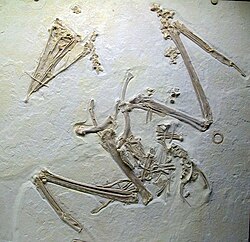Limnofregata
|
Limnofregata Temporal range: Early Eocene |
|
|---|---|
 |
|
| Skeleton of L. azygosternon in the Field Museum of Natural History. | |
| Scientific classification | |
| Kingdom: | Animalia |
| Phylum: | Chordata |
| Class: | Aves |
| Order: | Suliformes |
| Family: | Fregatidae |
| Subfamily: |
Limnofregatinae Olson, 1977 |
| Genus: |
†Limnofregata Olson, 1977 |
| Species | |
|
†Limnofregata azygosternon (type) |
|
†Limnofregata azygosternon (type)
†Limnofregata hasegawai
†Limnofregata hutchisoni
Limnofregata ("Freshwater frigatebird") is an extinct genus of primitive frigatebird. The two known species were described after fossils from the Early Eocene Green River Formation (c.49 million years ago) of Wyoming. A number of good complete and partial skeletons, some with feather impressions, are known of the type species, Limnofregata azygosternon, and L. hasegawai is known from two skulls and most of one torso.
Birds of the genus Limnofregata resembled modern frigatebirds, but had shorter less-hooked bills and longer legs, and longer slitlike nasal openings. They stood 30 to 40 centimetres (12 to 16 in) tall when on the ground and had a wingspan of about 100 to 120 centimetres (3 to 4 ft). The beak was shorter than that of modern frigatebirds, and lacked the typical hook at the end, resembling a strong booby beak more than that of today's frigatebirds. The species differ conspicuously in size, with L. hasegawai being as much larger when compared to L. azygosternon as today's largest species of frigatebird (Fregata minor) is compared to the smallest extant one (Fregata ariel). The bill of L. hasegawai was notably larger still than that of its congener, whereas its feet were smaller, echoing a pattern found in the extant Fregata species.
...
Wikipedia
